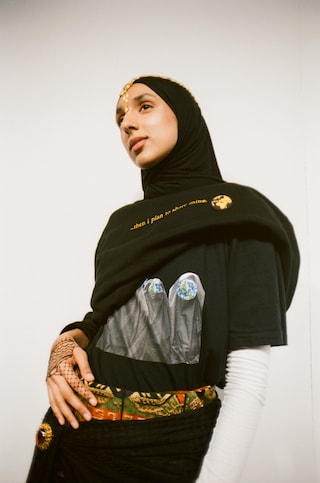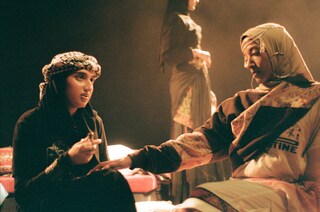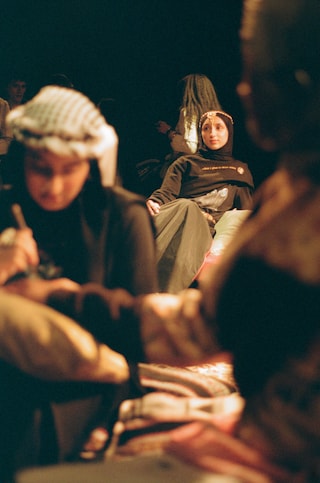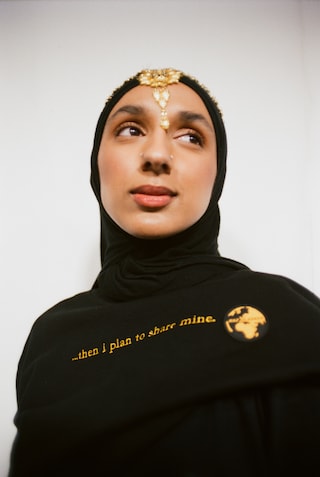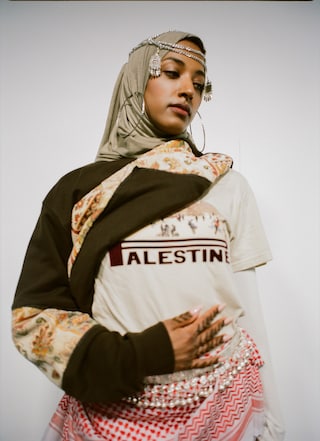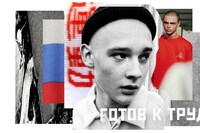A young man, about 23-years-old, reclines on a Persian carpet, soft furnishings propping him up by the elbow. He’s wearing an ink-black and olive shell suit, its fabric combined with sections of the traditional cloth that he lays on. The carpets continue to line the room, their twisted floral patterns providing the backdrop for a dynamic scene. In another spot, a woman sits similarly reclined, her hand resting on another’s knee who steadily dots henna onto her fingers. The woman’s abaya is made from the same shell suit material, also cut with traditional cloth panelling, and a duck-egg beret sits on her head. Throughout the room, books on Arab culture are scattered on varnished coffee tables, while children play on sofas, scribbling their thoughts into colouring books. Friends and relatives fill the space, chatting to one another while sipping Adeni shahi, a type of Yemeni tea arriving on florid silver platters. We’re in Kazna Asker’s grandmother’s living room, and the scene is relaxed, convivial, and free.
If you were in town for London Fashion Week, and wandered down to the Old Selfridges Hotel, you would’ve found yourself in this exact room. No, the scene described was not the living space of Asker’s grandmother, but the young designer’s faithful recreation of it, and the presentation for her AW24 collection What are we fighting for? Her friends and relatives did fill the room, but so did fashion industry professionals, there to witness Asker’s hybrid take on very British sportswear and traditional Yemini dress. It’s a style that’s earnt her acclaim across the industry, ever since she was the first Central Saint Martins grad to put a hijab on the runway at the university’s 2022 MA Fashion show.
Underpinning Asker’s work is an unyielding sense of community. Of Yemeni descent and hailing from Sheffield, her radical work is as much about real life activism as it is about the clothing on display. Fight For Me Sheffield, a short film screened during London Fashion Week’s SS24 season, saw Asker arrive at the city’s Education, Children and Families meeting in Sheffield Town Hall to fight for greater protections for POC teachers. This season’s presentation was also twinned with an action in Sheffield, where young people stood in solidarity, wearing t-shirts with ‘What are we fighting for?’ emblazoned across. And as one of the only designers on the London schedule actively calling for a ceasefire in Gaza, activism has always been at the heart of Asker’s craft. Now, with the backing of the British Fashion Council’s NEWGEN scheme, her vital work will continue to flourish for seasons to come.
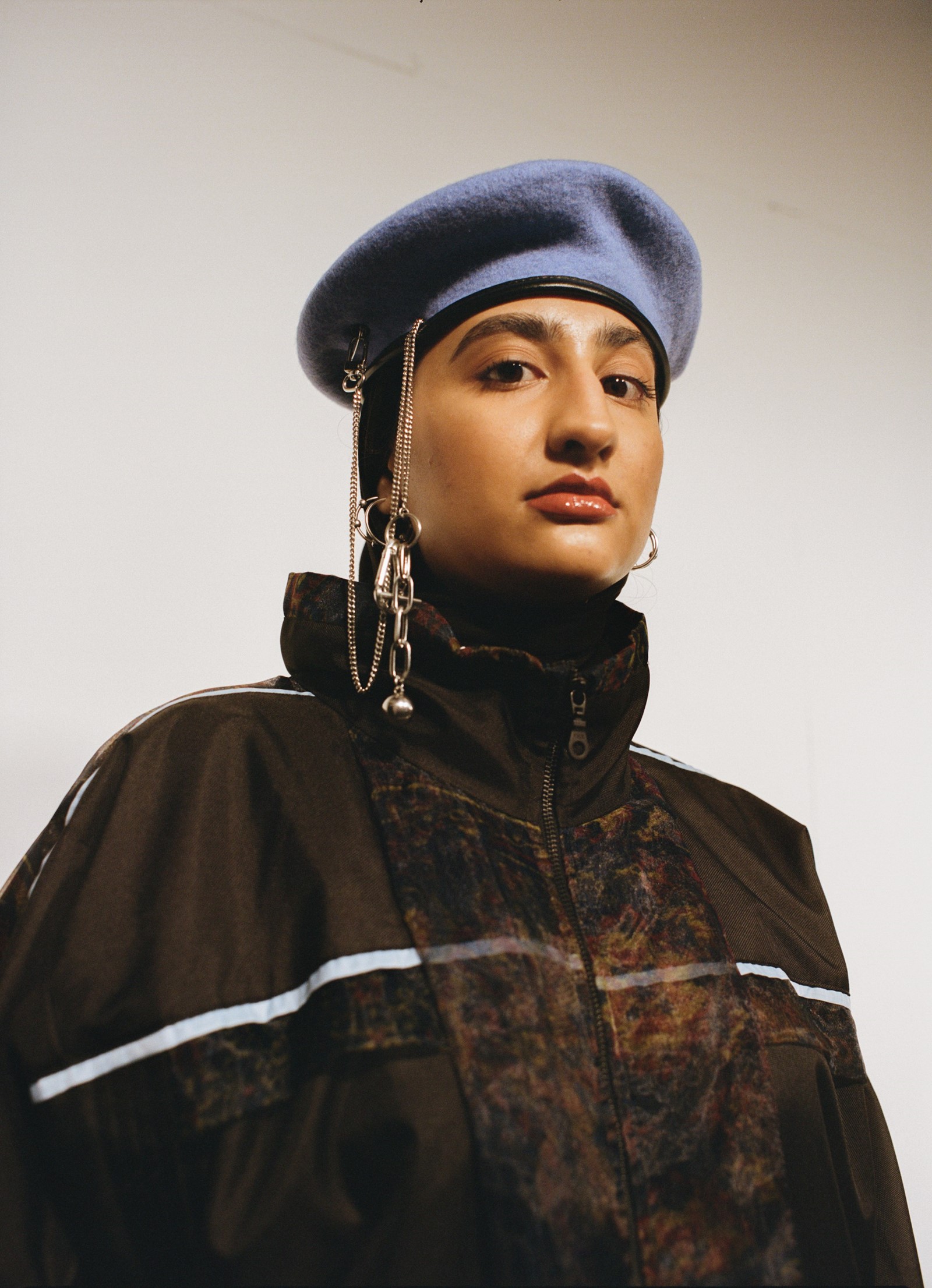
In the conversation below, we talk to Asker about the inspiration behind her hybrid clothes, what it’s like approaching fashion week from outside of the London bubble, and who she hopes to inspire with her radical work.
Hi Kazna! First of all congratulations on your LFW presentation. Was there an exact moment or spark of inspiration that led you to create the show?
Kazna Asker: Ah, thank you! It’s always been a dream of mine to create a show, presentation or exhibition of some sort, or any platform where I am able to curate a ‘world’ that people can immerse themselves into. After taking part in NEWGEN, I thought this would be the perfect opportunity to showcase my world – whether its fashion, imagery, books, family, community work, charity – everything that inspires the ethos behind my brand.
Were there any obstacles that you faced in the run up to the presentation?
Kazna Asker: There were a few battles that we had to face to represent our community sincerely, which was very crazy because my presentation was called What are we fighting for? But I’m super grateful that I’m surrounded by like-minded people who supported me throughout. I think when it involves activism, there is always going to be a fight or an obstacle, but hopefully we can continue to challenge the norms and advocate for change so the next generation of designers can fly.
“When it involves activism, there is always going to be a fight or an obstacle, but hopefully we can continue to challenge the norms and advocate for change so the next generation of designers can fly.” – Kazna Asker
How did it feel to have strangers wandering around your grandmother’s living room?
Kazna Asker: I did have a moment where I thought that this is so crazy – all these fashion and industry people are walking around in my grandma’s living room, drinking Adeni shahi [Yemeni tea], talking to all my family members like they’re family, seeing the guys from the youth club wearing my clothes, looking at imagery of the local businesses, teachers and counsellors on the storyboard.
But I felt so comfortable – maybe because it felt like home and everything was personal to how I grew up. I feel so grateful that I get to invite people into my world and meet my community, it’s just crazy that it’s through a fashion presentation at London Fashion Week.
We’ve seen a lot of designers on the schedule approach nostalgia in different ways. How does delving into the past inform your own practice?
Kazna Asker: Me and my brother were just talking about this, and how we believe our Yemeni culture – or maybe it’s just an immigrant culture in Sheffield – is built on nostalgia and the importance of storytelling. I think a lot of us in our community come from war torn countries, and our families don’t really have tangible memories like pictures and videos of their lives in Yemen, Somalia, Libya, etc. – so they passed all their generational knowledge through storytelling. My dad tells me stories, and I heard the exact ones from my grandad, and he heard them from his dad. I think that approach to nostalgia is really built into my practice, and I really love storytelling through my clothes and concepts.
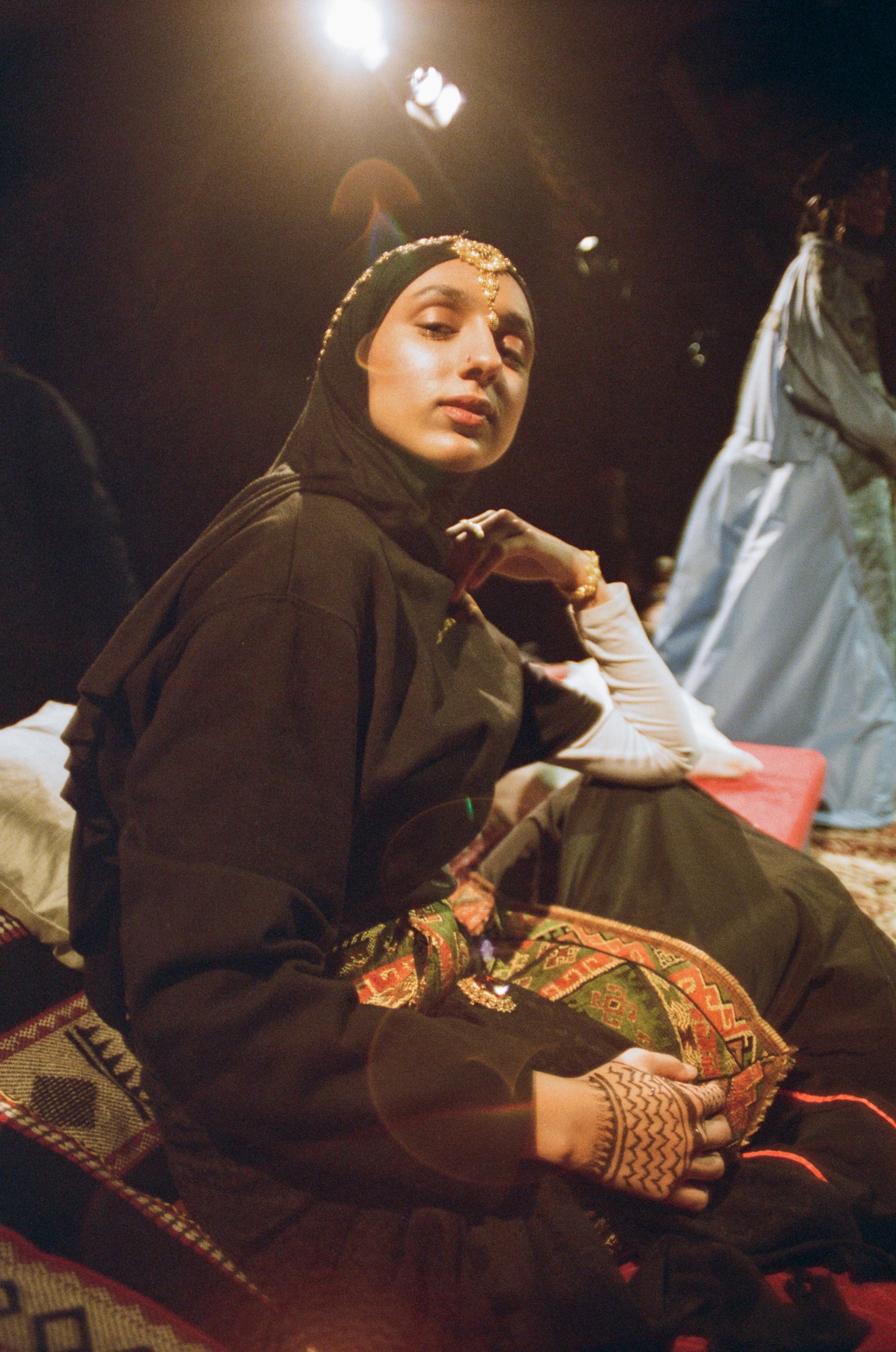
What first inspired you to combine tracksuits with traditional silhouettes?
Kazna Asker: Growing up in the north, I think tracksuits are definitely part of the culture. Then being Yemeni, and going to Arabic school on the weekends, I would always see hijabs and abayas and traditional Islamic clothing. When I was on the MA, my research would include a lot of my cousins in their tracksuits and puffer jackets next to my grandma and aunties in their traditional clothing, so my goal was to combine the two and explore the intergenerational perspectives on culture and faith.
As one of the few designers on the LFW schedule advocating for a ceasefire in Gaza, do you ever worry that your political stances could work against you in the fashion industry? Or do you just not care?
Kazna Asker: I’ve been organising fundraisers in my local community for Palestine and Yemen since I was 16 years old, and I remember dedicating my whole GCSE art project to Palestine, and signing up to run a half marathon to raise money without even training. I never really thought about how the industry could not agree with my political stances. The activism and charity work has been so normal and natural to me. If it does work against me, then it is what it is. My only priority has only ever been to represent real people in real time with real hardships with sincerity. So any opportunity or platform I have to raise awareness, advocate for a ceasefire, and shout ‘Free Palestine’, I’m going to take it!
“I think it’s super easy, especially in fashion, to use ‘community’ as a gimmick or marketing strategy” – Kazna Asker
What would you say are the best things about coming from outside of the London bubble?
Kazna Asker: I’m currently based in London, but I go back to Sheffield so often. I think the best thing about it is, when I came to do my MA, I was super naive and open minded, and I think I carried that innocence into my brand. So I get to push boundaries and try new things and represent people and combine everything I believe in with fashion, because I don’t know what the right way to do things is. There are amazing opportunities in London that I wasn’t exposed to before, and since my work is rooted in my Northern upbringing, I get the best of both worlds.
What does community mean to you in 2024?
Kazna Asker: Right now, I really believe community is only about the action. I think it’s super easy, especially in fashion, to use ‘community’ as a gimmick or marketing strategy, or just as representation. In 2024, it’s more about the action behind the word and how we can actively go out of our way to help people.
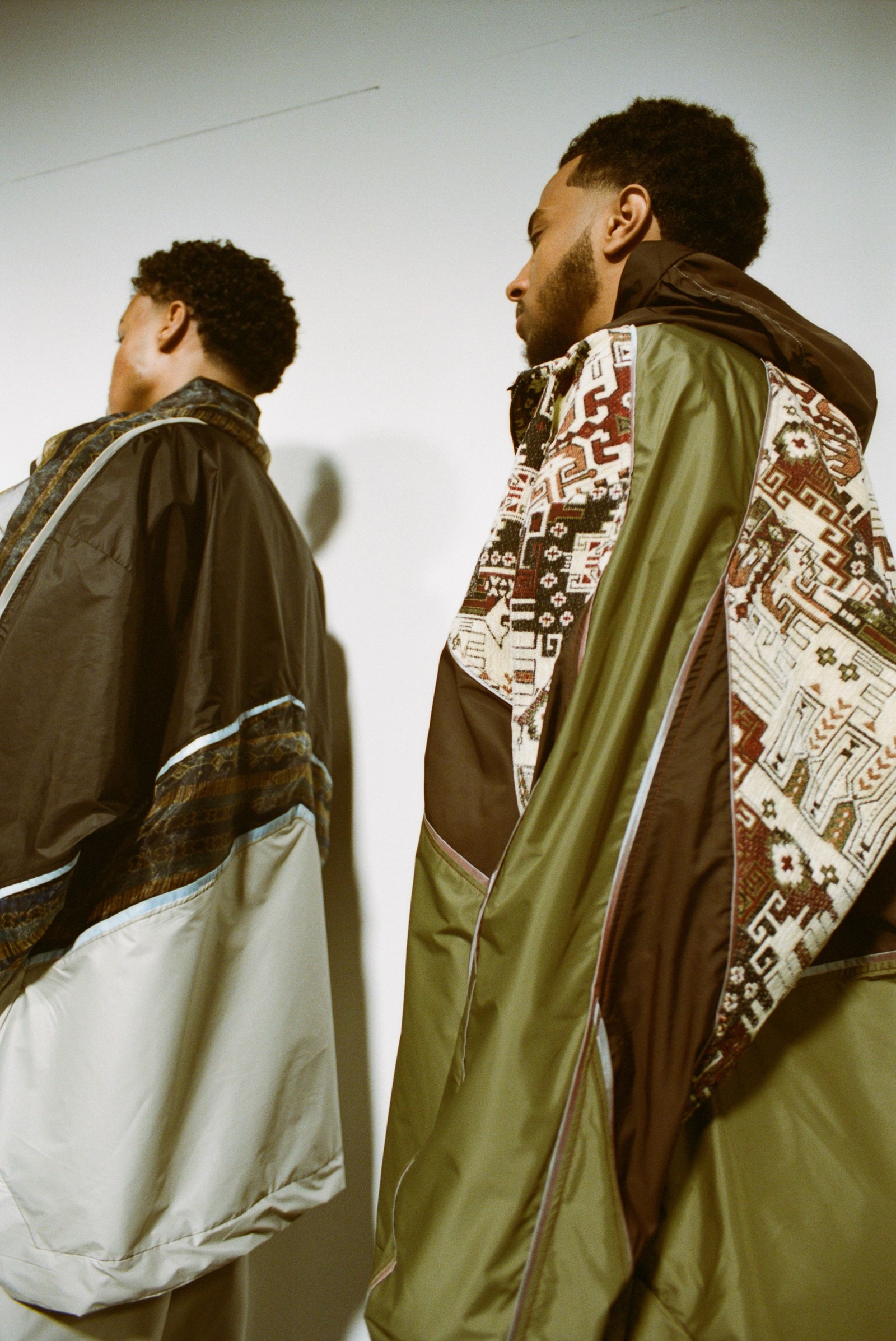
Who are your design influences and what ways have they impacted your craft?
Kazna Asker: I think the way Virgil Abloh used fashion as a tool for a greater impact, how he brought his community alongside him to every opportunity, and how he was able to work his way up into rooms to represent a whole generation is super inspiring to me.
And if you could collaborate with any contemporary designer(s), who would that be?
Kazna Asker: I think I would love to collaborate with a contemporary sportswear brand and take the sportswear/tracksuit element further with my aesthetic of Middle Eastern culture in textiles and silhouettes. I always think about this question and I find it so hard to answer. I would love to one day collaborate with a brand that’s the complete opposite of mine, like a couture designer or accessories designer, and see the impact the two worlds could create.
What do you hope to inspire in people when you ask the question ‘What are we fighting for?’
Kazna Asker: I hope people are able to reflect mostly, especially with everything that’s happening in the world right now. Also, the key word is ‘we’, and the question is more of an open ended one – a discussion on how we can come together and stand for something collectively. If anything, I hope it starts a conversation.


